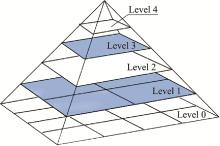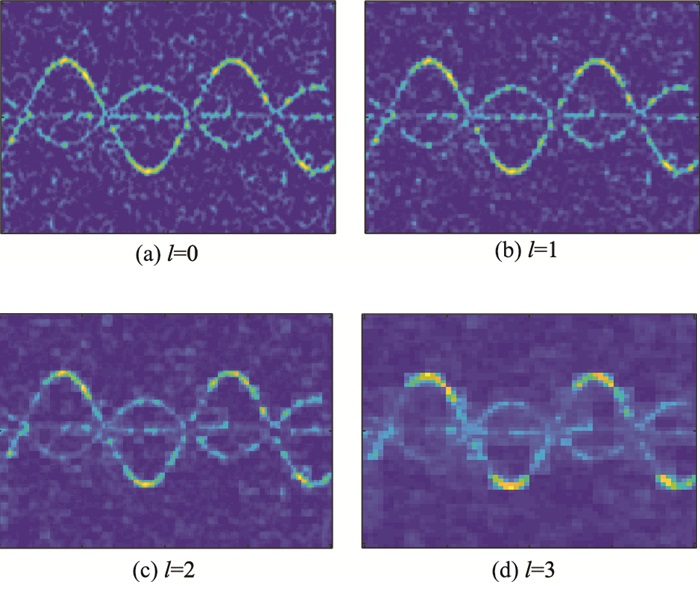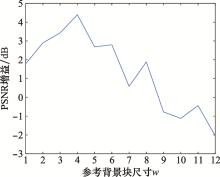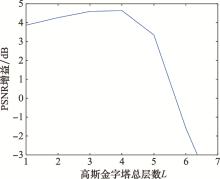Systems Engineering and Electronics ›› 2022, Vol. 44 ›› Issue (4): 1148-1157.doi: 10.12305/j.issn.1001-506X.2022.04.10
• Sensors and Signal Processing • Previous Articles Next Articles
Micro-motion signal enhancement method based on multi-resolution saliency filtering
Minglei TANG, Wenpeng ZHANG*, Weidong JIANG, Xunzhang GAO
- College of Electronic Science and Technology, National University of Defense Technology, Changsha 410000, China
-
Received:2021-02-05Online:2022-04-01Published:2022-04-01 -
Contact:Wenpeng ZHANG
CLC Number:
Cite this article
Minglei TANG, Wenpeng ZHANG, Weidong JIANG, Xunzhang GAO. Micro-motion signal enhancement method based on multi-resolution saliency filtering[J]. Systems Engineering and Electronics, 2022, 44(4): 1148-1157.
share this article
| 1 | CHEN V C , LI F , HO S S , et al. Micro-Doppler effect in radar: phenomenon, model, and simulation study[J]. IEEE Trans.on Aerospace & Electronic Systems, 2006, 42 (1): 2- 21. |
| 2 | 李康乐. 雷达目标微动特征提取与估计技术研究[D]. 长沙: 国防科学技术大学, 2010. |
| LI K L. Research on feature extraction and parameters estimation for radar targets with micro-motions[D]. Changsha: National University of Defense Technology, 2010. | |
| 3 |
ZHANG W P , LI K L , JIANG W D . Parameter estimation of radar targets with macro-motion and micro-motion based on circular correlation coefficients[J]. IEEE Signal Processing Letters, 2015, 22 (5): 633- 637.
doi: 10.1109/LSP.2014.2365547 |
| 4 | 赵若冰. 雷达目标的微多普勒特征建模与分析技术研究[D]. 南京: 南京理工大学, 2017. |
| ZHAO R B. Research on micro-Doppler feature modeling and analysis technology of radar target[D]. Nanjing: Nanjing University of Science and Technology, 2017. | |
| 5 | 林襄. 雷达目标多分量微动信号参数估计与分离技术研究[D]. 长沙: 国防科学技术大学, 2016. |
| LIN X. Research on radar multi-component micro-Doppler signal decomposition and parameter estimation[D]. Changsha: National University of Defense Technology, 2016. | |
| 6 | 李昆, 朱卫纲. 利用生成对抗网络的时频图像去噪和增强技术[J]. 电讯技术, 2020, 60 (5): 517- 523. |
| LI K , ZHU W G . Time-frequency image denoising and enhancement processing based on generative adversarial network[J]. Telecommunication Engineering, 2020, 60 (5): 517- 523. | |
| 7 | TORRES L, FRERY A C. SAR image despeckling algorithms using stochastic distances and nonlocal means[EB/OL]. [2021-02-01]. https//arxiv. org/abs/1308.4338v1. |
| 8 |
HEO Y C , KIM K , LEE Y . Image denoising using non-local means (NLM) approach in magnetic resonance (MR) imaging: a systematic review[J]. Applied Sciences-Basel, 2020, 10 (20): 7028.
doi: 10.3390/app10207028 |
| 9 |
CHEN H O , KONG N S P , IBRAHIM H . Bi-histogram equalization with a plateau limit for digital image enhancement[J]. IEEE Trans.on Consumer Electronics, 2009, 55 (4): 2072- 2080.
doi: 10.1109/TCE.2009.5373771 |
| 10 |
RODRIGUES C , PEIXOTO Z M A , FERREIRA F M F . Ultrasound image denoising using wavelet thresholding methods in association with the bilateral filter[J]. IEEE Latin America Transactions, 2019, 17 (11): 1800- 1807.
doi: 10.1109/TLA.2019.8986417 |
| 11 | PURANIKMATH S S , KALIYAPERUMAL V . Enhancement of SAR images using curvelet with controlled shrinking technique[J]. Remote Sensing Letters, 2016, 7 (1): 21- 30. |
| 12 | LIU S Q , SHI M Z , HU S H , et al. Synthetic aperture radar image denoising based on Shearlet transform using the context-based model[J]. Physical Communication, 2014, 13 (Part C): 221- 229. |
| 13 |
LI Y . A multifeature extraction method using deep residual network for MR image denoising[J]. Computational & Mathematical Methods in Medicine, 2020,
doi: 10.1155/2020/8823861 |
| 14 | ZHANG Z H , LIU Y P , LIU J N , et al. AMP-net: denoising-based deep unfolding for compressive image sensing[J]. IEEE Trans.on Image Processing, 2021, 30 (1): 1487- 1500. |
| 15 |
ZHANG Q , WU Y , ZHAO W , et al. Multiple-scale salient-region detection of SAR image based on Gamma distribution and local intensity variation[J]. IEEE Geoscience and Remote Sensing Letters, 2014, 11 (8): 1370- 1374.
doi: 10.1109/LGRS.2013.2293508 |
| 16 | TU S , SU Y . Fast and accurate target detection based on multiscale saliency and active contour model for high-resolution SAR images[J]. IEEE Trans.on Geoscience & Remote Sensing, 2016, 54 (10): 5729- 5744. |
| 17 | WANG H P , XU F , CHEN S S . Saliency detector for SAR images based on pattern recurrence[J]. IEEE Journal of Selected Topics in Applied Earth Observations & Remote Sensing, 2016, 9 (7): 2891- 2900. |
| 18 | WANG S G , WANG M , YANG S Y , et al. New hierarchical saliency filtering for fast ship detection in high-resolution SAR images[J]. IEEE Trans.on Geoscience & Remote Sensing, 2017, 55 (1): 351- 362. |
| 19 | NI W P , MA L , YAN W D , et al. Background context-aware-based SAR image saliency detection[J]. IEEE Geoscience & Remote Sensing Letters, 2018, 15 (9): 1392- 1396. |
| [1] | Jianyong ZHENG, Guanghui WEI. Time-frequency-energy analysis of electromagnetic signals based on multi-resolution dynamic modal decomposition [J]. Systems Engineering and Electronics, 2022, 44(5): 1468-1474. |
| [2] | Cheng FANG, Wen LU, Jingying JI, Yumeng SONG, Feifei LIANG, Zhiwei LUO. Correlation filter-tracking algorithm based on appearance similarity update [J]. Systems Engineering and Electronics, 2022, 44(1): 117-126. |
| [3] | Pengyu CAO, Chengzhi YANG, Limeng SHI, Hongchao WU. LPI radar signal enhancement based on DAE-GAN network [J]. Systems Engineering and Electronics, 2021, 43(9): 2493-2500. |
| [4] | Zhenghong PENG, Degui YANG, Xing WANG, Hao WANG, Zhengliang ZHU. Micro-Doppler separation and feature extraction algorithm based on trend estimation [J]. Systems Engineering and Electronics, 2021, 43(12): 3452-3461. |
| [5] | Zhiming XU, Xiaofeng AI, Kehong ZHOU, Feng ZHAO, Shunping XIAO. Simulation method of fully polarized bistatic radar echoes for micro-motion space targets [J]. Systems Engineering and Electronics, 2021, 43(10): 2789-2796. |
| [6] | Ying AN, Xunli FAN, Li CHEN, Pei LIU. Image fusion combining FABEMD with improved saliency detection [J]. Systems Engineering and Electronics, 2020, 42(2): 292-300. |
| [7] | LIU Songtao, JIANG Kanghui, LIU Zhenxing. Ship target detection of aerial reconnaissance image based on region covariance and objectness [J]. Systems Engineering and Electronics, 2019, 41(5): 972-980. |
| [8] | WANG Chao, YE Chunmao, WEN Shuliang. Micro-motion period estimation for targets with small LOS change in low PRF broadband radar [J]. Systems Engineering and Electronics, 2018, 40(9): 1945-1952. |
| [9] | LIU Songtao, LIU Zhenxing, JIANG Kanghui. Image target segmentation method based on fuzzy Renyi entropy and region growing#br# [J]. Systems Engineering and Electronics, 2018, 40(8): 1693-1701. |
| [10] | WANG Chen, FAN Yangyu. Saliency detection method based on dynamic guided filtering [J]. Systems Engineering and Electronics, 2018, 40(6): 1391-1397. |
| [11] | CHEN Rong, FENG Cunqian, HE Sisan, RAO Yi. Micro-motion features estimation method using ISAR images for ballistic targets [J]. Systems Engineering and Electronics, 2017, 39(7): 1500-1505. |
| [12] | WANG Guan-jun, WU Zhi-yong, YUN Hai-jiao, LIU Xue-chao, LIANG Min-hua, YANG Hua. Design of self-adaptive focus window for photoelectrical theodolite [J]. Systems Engineering and Electronics, 2016, 38(7): 1508-1515. |
| [13] | WANG Weilin, CHEN Lei, LEI Yongjun. Micro-motion analysis of decoy in midcourse of ballistic missile [J]. Systems Engineering and Electronics, 2016, 38(3): 487-492. |
| [14] | MAO Erke1,2, FAN Huayu1,2. Synthetic wideband pulse Doppler radar [J]. Systems Engineering and Electronics, 2016, 38(12): 2717-2724. |
| [15] | LU Hong, LI Hong-sheng, FEI Shu-min, CHENG Yong. Block level saliency centroid representation and multi-level association based multi-target tracking [J]. Systems Engineering and Electronics, 2015, 37(9): 2182-2190. |
| Viewed | ||||||
|
Full text |
|
|||||
|
Abstract |
|
|||||









































